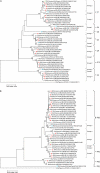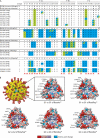Genetic analyses reveal differences in the VP7 and VP4 antigenic epitopes between human rotaviruses circulating in Belgium and rotaviruses in Rotarix and RotaTeq
- PMID: 22189107
- PMCID: PMC3295124
- DOI: 10.1128/JCM.05590-11
Genetic analyses reveal differences in the VP7 and VP4 antigenic epitopes between human rotaviruses circulating in Belgium and rotaviruses in Rotarix and RotaTeq
Abstract
Two live-attenuated rotavirus group A (RVA) vaccines, Rotarix (G1P[8]) and RotaTeq (G1-G4, P[8]), have been successfully introduced in many countries worldwide, including Belgium. The parental RVA strains used to generate the vaccines were isolated more than 20 years ago in France (G4 parental strain in RotaTeq) and the United States (all other parental strains). At present, little is known about the relationship between currently circulating human RVAs and the vaccine strains. In this study, we determined sequences for the VP7 and VP4 outer capsid proteins of representative G1P[8], G2P[4], G3P[8], G4P[8], G9P[8], and G12P[8] RVAs circulating in Belgium during 2007 to 2009. The analyses showed that multiple amino acid differences existed between the VP7 and VP4 antigenic epitopes of the vaccine viruses and the Belgian isolates, regardless of their G and P genotypes. However, the highest variability was observed among the circulating G1P[8] RVA strains and the G1 and P[8] components of both RVA vaccines. In particular, RVA strains of the P[8] lineage 4 (OP354-like) showed a significant number of amino acid differences with the P[8] VP4 of both vaccines. In addition, the circulating Belgian G3 RVA strains were found to possibly possess an extra N-linked glycosylation site compared to the G3 RVA vaccine strain of RotaTeq. These results indicate that the antigenic epitopes of RVA strains contained in the vaccines differ substantially from those of the currently circulating RVA strains in Belgium. Over time, these differences might result in selection for strains that escape the RVA neutralizing-antibody pressure induced by vaccines.
Figures




References
-
- Ball JM, Tian P, Zeng CQ, Morris AP, Estes MK. 1996. Age-dependent diarrhea induced by a rotaviral nonstructural glycoprotein. Science 272:101–104 - PubMed
-
- Banyai K, et al. 2009. Trends in the epidemiology of human G1P[8] rotaviruses: a Hungarian study. J. Infect. Dis. 200(Suppl 1):S222–S227 - PubMed
-
- Boom JA, et al. 2010. Effectiveness of pentavalent rotavirus vaccine in a large urban population in the United States. Pediatrics 125:e199–e207 - PubMed
Publication types
MeSH terms
Substances
Grants and funding
LinkOut - more resources
Full Text Sources
Medical

